Evolution of Athlete Adaptation 1960-2020: Jonty Skinner On The Flatlining Of Pioneering Swimming Speed
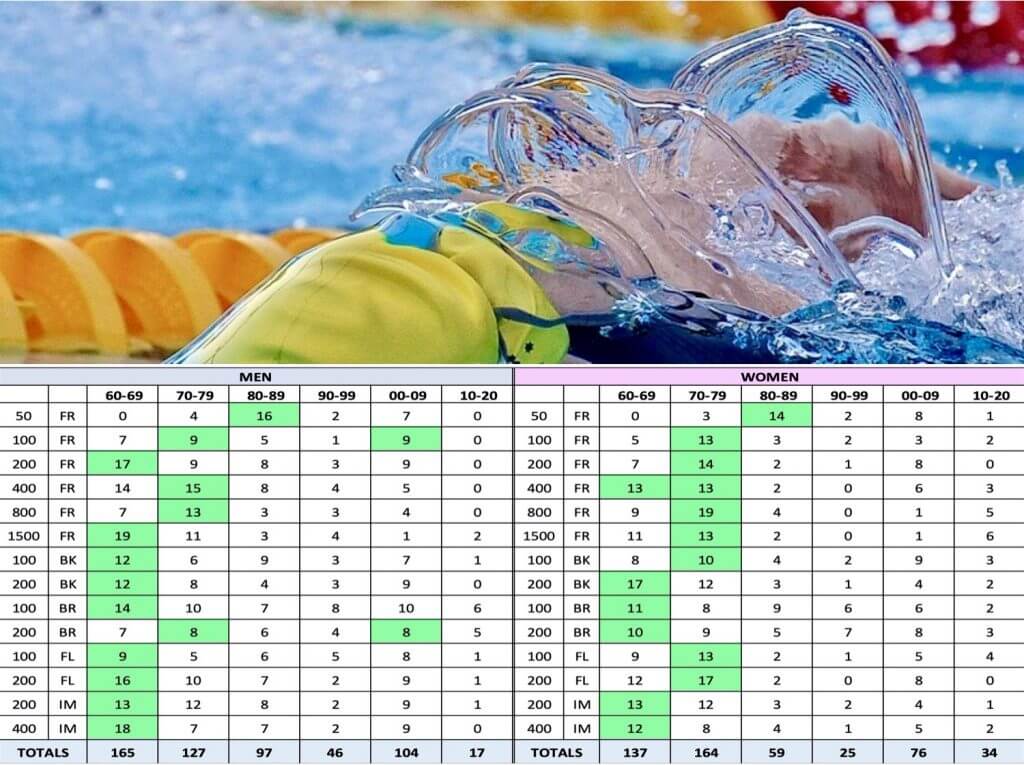
As a swimmer, Jonty Skinner went down in history as the man who crushed the swimming speed that crushed the rest: 20 days after after American Jim Montgomery clocked a then stunning 49.99sec over 100m freestyle for Olympic gold at Montreal 1976, Skinner, locked out of the race by the apartheid policies of his country of birth, South Africa, rocked 1976 United States Summer National Swimming Championships in Philadelphia with a 49.44 victory over the newly crowned Olympic champion and the Montreal silver medallist, USA team-mate Joe Bottom. Skinner’s standard record stood until April 1981, when Rowdy Gaines clocked 49.36 in Texas.
Recently retired from Indiana, Skinner, already a part of our 2020s vision series for the vision he delivered two years before the shiny suits were sunk, looks at the evolution of athlete adaptation, its relation to swimming speed, asks ‘is the pace of progress flatlining and why’, are coaches harnessing the tools available to them, is generational difference significant and can it be taken into account when coaches plan training programs and approaches – and then he picks one of three options when it comes to what happens next … some of the issues highly relevant to one of the themes we’ve been considering, Athlete Sustainability
Commentary By Jonty Skinner
I was ruminating of late on the evolution of swimming and swimming speed a few days ago and then realized that my thoughts needed a basis of information to give them context. Hence the following chart tracking the number of times a world record was broken in each decade. I’ve kept this focused on Long Course Meters since SCY and SCM are essentially a different sport.
The Count Of Pioneering Swimming Speed 1960-2020
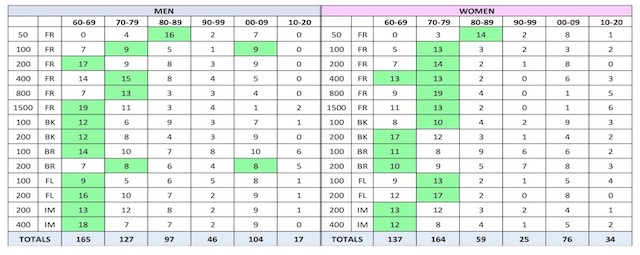
Graphic Courtesy: Jonty Skinner
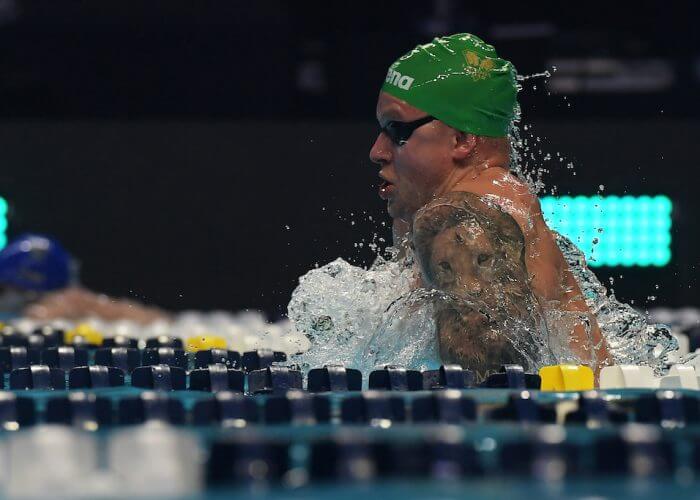
Adam Peaty wears his lion on his sleeve – Photo Courtesy: Gian Mattia D’Alberto/LaPresse
Before I get into my thoughts on the subject, I need to clear up some anomalies that occur due to a change in the social or racing environment.
- The 50 free wasn’t a recognized event until the 1970’s. That fact pushed the initial bulge in that event to a decade later in men and women.
- Major breaststroke rule changes in the 1980’s perpetuated growth into the 90’s and then additional changes in the 2000’s extended that growth. We’ve also gone through major strategy changes in the stroke with Adam Peaty and Anton Chupkov changing the tactical options in their respective domains. The other reason breaststroke has progressed since 2010 is that the critical mass of swimmers close to the World Record is high enough to continue to push the event forward. On the male side, 7 swimmers contribute to the growth in breaststroke beyond 2010.
- Backstroke rule changes regarding the turn and the development of the underwater dolphin extended growth beyond the 70’s
- Butterfly was in some ways rejuvenated when swimmers explored the value of the underwater dolphin options and became better at transferring underwater velocity into swimming velocity (swimming speed in a specific direction).
- The technical suit era had an obvious impact between 2007 and 2009. Men took more advantage of this than the women since they went from jammers to full body options. (104 to 76)
- Since 2010 the women have had a much better track record than the men since they continue to wear suits that cover a greater percentage of the body. (17 to 34)
- There is the impact of the DDR in the 1970’s and early 1980’s but they didn’t contribute to as many new world records as I expected.
- The skirt from the female suit was removed in the early 1970’s and would have had a huge impact on times. That improvement in suit technology during that time period could have contributed to the possible disparity between the men and the women in the 1970’s
- Although Title IX was introduced in the 1970’s it’s true impact on swimming didn’t occur until the late 1980’s and 1990’s. The evolution of women’s sports in college resulted in a diminishing talent pool for swimming and could have impacted the 1990’s decade on the women’s side. More sports offered college scholarships in a variety of sports and teenagers had many options to choose from when looking to get their college education paid for.
There are probably some additional items that my brain is not picking up, but those are the main ones.
The discussion in my mind centers around the growth that occurred in the 1960’s and 1970’s. It’s interesting to note that the men have 9 events that peak in the 60’s and the women have 8 that peak in 70’s.
There is no doubt that the DDR had a small hand in this, but in my mind the answer is that women reacted better to the volume based training stimulus and that contributed to their bulge and the fast-forward of swimming speed in the 1970’s.
It should also be mentioned that the majority of the female swimmers in the 1970’s were teenagers, and even after college scholarships entered the arena and female athletes stayed active longer, it still didn’t change the flatline of the 1990’s. Granted the sport was primed for the reaction to the kind of training in the late 1960’s into the 1970, but that robust period hasn’t been duplicated at all after 1979. Since we are now dealing with the post Tech Suit era, are we heading into a flatline period where the 1990’s become the norm again?
Because of my age I have listened to endless discussions of how the way we trained in the last century is the only way to develop superior athletes. Opinion is that we lost our edge because we moved away from those endurance-based development options. There is no question that interval training, equipment technology and the concept of shaving caused a significant uptick in swimming speed in the specific sphere of the number of world records in swimming in the 1960’s. However, that flood continued on that same path in the 1970’s when the world began to explore high intensity volume-based training.
Influences On The Gender gap and Swimming Speed
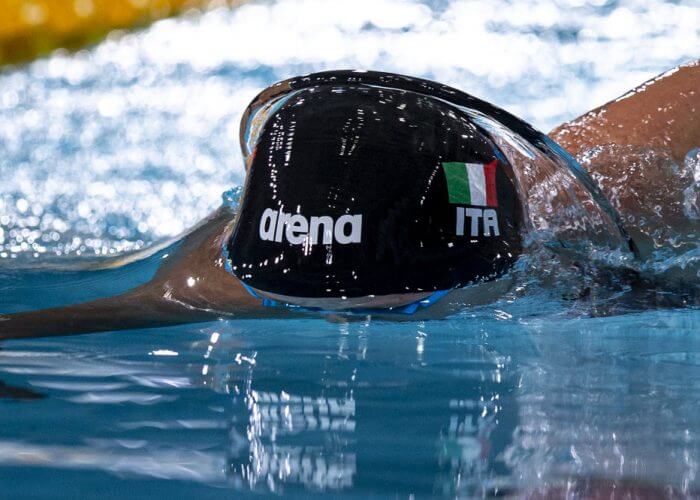
Federica Pellegrini with a crown of water as the queen of 200m free racing – Photo Courtesy: Patrick B. Kraemer
Although both sexes reacted well to the change in stimulus during that period, I find it interesting that it seems as though the women reacted better than the men to the change to a higher volume option. Women have always been looked at as more aerobic in nature and better suited to environments that involve that adaptation focus, so even though we have that DDR factor, I still think that women reacted very well to style of development at that time. Post the 1970’s there is a clear decay in number of broken world records in the 1980’s, and there is no question that the sport began to flat line in the 1990’s. It’s also clear that the women flatlined more than the men.
The lingering question is… was that due to the swimming world moving away from high intensity volume training, or had we maximized that adaptation option relevant the athlete training pool we were encountering during that period. (Title IX hypothesis) We all know that in order to continue to improve there has to be a change in stimulus, so was the late 80’s and 90’s a strong indication that we had maximized the aerobic endurance option completely?
For those who see these numbers as fitting your narrative, you will be all over the fact that yes, we’ve lost the edge and as a sport are doomed to the doldrums of the 1990’s. When you balance that thought with the evolution towards race speed specific training and the advent of the USRPT system, it might reinforce the fact that we should definitely return to the 1970’s if we want to regain the edge on improvement.
Speaking plainly, there is no way to move forward if we’re comfortable with pointing fingers and espousing whatever narrative suits your cause since that doesn’t solve the issue.As a community we have to understand that we are in jeopardy of flatlining and start talking about what we need to do to change that trend. If there is one thing that our sport has been appalling at, it has been the in-depth documentation of successful programs. Very few coaches in this country (United States) track and map everything they do, and correlate testing systems to validate their results. Because of those shortcomings, we have zero information that incorporates development data and science in a way that allows young emerging coaches to absorb our/your successful strategies into their coaching philosophies.
The genesis of the current coach experience/educational problem is rooted in the fact that for years we have been cultivated via an anecdotal centric educational system. There is little out there that provides coaches with actual road maps they can use to develop successful programs.
Bill Boomer was the first person who said to me that change is generational. There is no questioning that fact. Where that impacts us as a profession is that until we develop an educational system that isn’t anecdotal and provides data and information that coaches can use in an effective manner, we will slow our ability to make that generational leap. We are essentially too comfortable doing what we think works and anemic at finding the courage to map and explore different options in pursuit of helping the swimmer be the best they can be as they chase swimming speed.
With most coaches in the country basing their training on anecdotal systems and essentially going with the flow on a daily basis, there is no way for those coaches to truly understand what works best for them. As the coach evolves, any mild cases of success begin to limit the training template. The major question in my mind is simply this:
Does the coach make the athlete, or does the athlete make the coach?
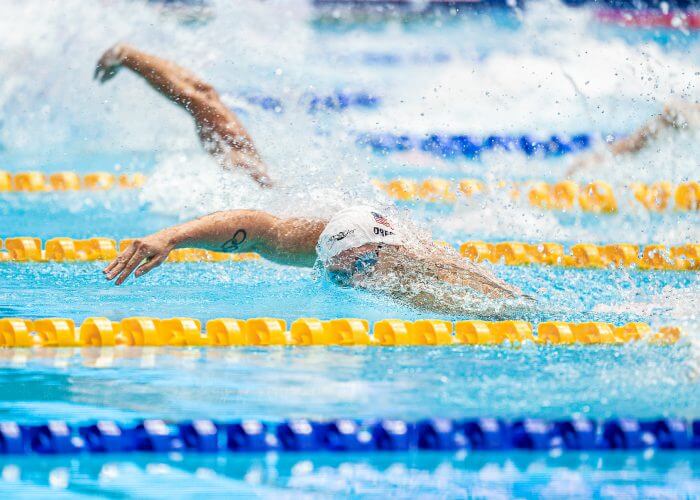
Caeleb Dressel – Photo Courtesy: Becca Wyant
It’s a good question to ponder since, when that true athlete comes along, and a coach has some success, they bask in the sunshine of that athlete and believe they have the formula to success. In short, they think that there is no other way to develop athletes. These success stories are shared at conventions and the collateral damage of that kind of success is that other young coaches see that success and try to mimic it without ever exploring or developing on their own. This endless cycle has eviscerated our ability to understand what really works.
The role of high intensity endurance-based training. In today’s world there has to be a small segment of swimmers who need and can handle the kind of work that generated the dynamo of the late 1960’s into the 1970’s. When you draw in the fact that the large majority of the swimmers who contributed to the depth in swimming during that growth period were essentially very young on the women’s side, it makes me think that we need to look at how we develop female athletes during their teenage years. There was a period where if you didn’t “make it” by age 16 you were “washed up”.
However, as college evolved, it played a major role in sustaining athlete’s careers and maturity played a strong role in who contributed to the top end results.
Even so, even swimmers like Ledecky had some of their greatest seasons prior to entering college, and I still question whether the training template for swimmers like that should change as they become mature adults. Since I’m debating a system that was successful fifty years ago, we should be wondering whether Gen X and Gen Z swimmers would be able to handle the rigors of the 1970’s style program. If you’re questioning whether they can, I’m right there with you.
Could the current media-centric “now” generation, slog through miles and miles of mind-numbing meters and stay with it. My mind tells me that there is without a doubt a place for this style of training based on the physiology of the athlete and that it should be age sensitive in their development process. We need to have a career plan for pre-teen swimmers who fit this specific profile. However, having no institutional science/data-based knowledge, we have no tested path to identify these swimmers and certainly specific path that they can follow.
Coaching Options …
- We all know that women and men respond very differently to adaptation and rest, so should we take the emerging women back to the 70’s and find a custom hybrid for the men?
- Would Eddie Reese have reached the same level of success doing everything he has done in training his athletes, but had women in the pool instead of men?
Change nothing except the sex of the athletes in the environment. Now before people jump off the deep end, that was hypothetical and germane to the dichotomy between the sexes.
There is no doubt that Eddie would have adapted to women just as well as he adapted to men, but the question remains, do women and men need to be stimulated inside different systems, or is there one system that fits both?
There are currently a number of “less yardage” power-based programs evolving in the United States. College programs are using less yardage and in some institutions, gimmicks to attract elite athletes, so the opportunity is there to find a career hybrid for women that might be successful and have an impact on swimming speed. However, many of those successful programs are showing better results in the short pool than the long pool, and I don’t see anything in the system that is both successful and documents everything they are doing.
After thirty years of computers and the ability to test and track viable training templates, you’d think we would have the answer, but until leadership sees and understands the importance of this logic, we won’t make any progress.
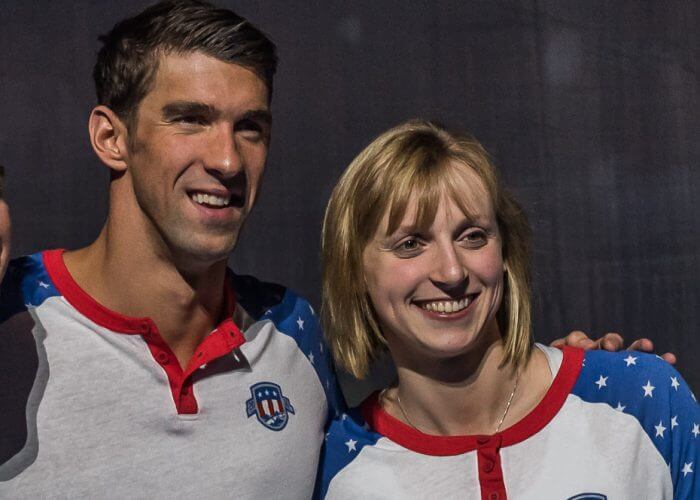
Michael Phelps and Katie Ledecky – powerhouses of swimming speed – Photo Courtesy: Peter H. Bick
As a profession we need to expect more of our educational system and expect more in terms of concrete science-based data to develop the critical mass of swimmers that will help spawn new world record holders. We can’t get infatuated with swimmers like Katie Ledecky or Michael Phelps or Caeleb Dressel since making the leap into the next paradigm will be more about developing the underlying talent than marvelling at those individual phenoms.
We can learn from the 1970’s and its bull run on swimming speed, but we have to find and explore new ways to develop the talent we have in the pool. We all knew that the post “tech suit” era would be a struggle, but unless we are willing to look change in the eye, we’ll be left with three options:
- Nothing changes and we flatline as a sport.
- FINA brings back the tech suit to regenerate excitement in the sport
- We recognize that we have an issue and start solving it.
As a purest I have no interest in option 2 since it essentially kicks the pull buoy down the road and all but guarantees option 1.
Option 3 has been staring us in the face for three decades now, and in my mind it’s time we dealt with it. I can certainly understand the mindset of coaches who played a huge part in the 60’s and 70’s boom, but we all know that the quickest way to declining fortunes is to not change anything.
We should also be cognizant of the fact that huge gains were there to be made at that time, and to never want to do anything other than that type of work because of it’s success at that time is a limiting statement in itself.
Flatlining is the product of a constant regimen, and in my mind, we should be looking at ways to stimulate the action potential in the brain on a daily basis. Finding ways to change the training environment to get the best of all worlds will be the key component to the future in this sport.
- All commentaries are the opinion of the author and do not necessarily reflect the views of Swimming World Magazine, the International Swimming Hall of Fame, nor its staff.




Very interesting
Brilliantly thought provoking ??
Jonty, thank you one more time for helping our son in 1978 and our grandson in 2020 with their stroke technique development which contributed greatly to their ability to be as good as they could be; based on those experiences and understanding that proper training is essential (and agreeing your points about how we need to be more scientific and open minded in figuring out what those methods are for each swimmer), I think an equally important factor for more world records will be in the area of stroke technique development; the results of any training program will be limited if the swimmer does not incorporate into their swimming technique the principles of hydrodynamics that minimize their resistance and maximize their power generation; therein lies a subject of discussion and debate for another article that no one is more qualified to lead than you; I look forward to that discussion